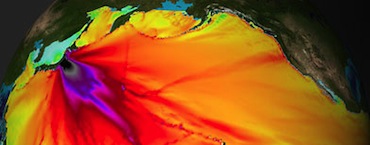

Japan quake causes emergencies at 5 nuke reactors
 By JEFF DONN - Associated Press,MARI YAMAGUCHI - Associated Press | AP – Sat, Mar 12, 2011 12:53 PM PHT
By JEFF DONN - Associated Press,MARI YAMAGUCHI - Associated Press | AP – Sat, Mar 12, 2011 12:53 PM PHT
Japan declared states of emergency for five nuclear reactors at two power plants after the units lost cooling ability in the aftermath of Friday's powerful earthquake. Thousands of residents were evacuated as workers struggled to get the reactors under control to prevent meltdowns.
Operators at the Fukushima Daiichi plant's Unit 1 scrambled ferociously to tamp down heat and pressure inside the reactor after the 8.9 magnitude quake and the tsunami that followed cut off electricity to the site and disabled emergency generators, knocking out the main cooling system.
Some 3,000 people within two miles (three kilometers) of the plant were urged to leave their homes, but the evacuation zone was more than tripled to 6.2 miles (10 kilometers) after authorities detected eight times the normal radiation levels outside the facility and 1,000 times normal inside Unit 1's control room.
The government declared a state of emergency at the Daiichi unit — the first at a nuclear plant in Japan's history. But hours later, the Tokyo Electric Power Co., which operates the six-reactor Daiichi site in northeastern Japan, announced that it had lost cooling ability at a second reactor there and three units at its nearby Fukushima Daini site.
The government quickly declared states of emergency for those units, too. Nearly 14,000 people living near the two power plants were ordered to evacuate.
Japan's nuclear safety agency said the situation was most dire at Fukushima Daiichi's Unit 1, where pressure had risen to twice what is consider the normal level. The International Atomic Energy Agency said in a statement that diesel generators that normally would have kept cooling systems running at Fukushima Daiichi had been disabled by tsunami flooding.
Officials at the Daiichi facility began venting radioactive vapors from the unit to relieve pressure inside the reactor case. The loss of electricity had delayed that effort for several hours.
Plant workers there labored to cool down the reactor core, but there was no prospect for immediate success. They were temporarily cooling the reactor with a secondary system, but it wasn't working as well as the primary one, according to Yuji Kakizaki, an official at the Japanese nuclear safety agency.
Even once a reactor is shut down, radioactive byproducts give off heat that can ultimately produce volatile hydrogen gas, melt radioactive fuel, or even breach the containment building in a full meltdown belching radioactivity into the surroundings, according to technical and government authorities.
Despite plans for the intentional release of radioactivity, Chief Cabinet Secretary Yukio Edano said the 40-year-old plant was not leaking radiation.
"With evacuation in place and the ocean-bound wind, we can ensure the safety," Edano said at a televised news conference early Saturday.
It was unclear if the elevation of radioactivity around the reactor was known at the time he spoke.
The outside measurement of radiation at Daiichi was far below the allowed limit for a year, other officials said, reporting that it would take 70 days standing at the gate to reach the yearly limit.
Dr. Irwin Redlener, a pediatrician who runs a disaster preparedness institute at Columbia University, said the reported level of radiation outside the plant would not pose an immediate danger, though it could lift the rate of thyroid cancer in a population over time.
However, he called the reported level inside the plant extraordinarily high, raising a concern about acute health effects. "I would personally absolutely not want to be inside," he said.
While the condition of the reactor cores was of utmost concern, Tokyo Electric Power Co. also warned of power shortages and an "extremely challenging situation in power supply for a while."
The Daiichi site is located in Onahama city, about 170 miles (270 kilometers) northeast of Tokyo. The 460-megawatt Unit 1 began operating in 1971 and is the oldest at the site. It is a boiling water reactor that drives the turbine with radioactive water, unlike pressurized water reactors usually found in the United States. Japanese regulators decided in February to allow it to run another 10 years.
The temperature inside the reactor wasn't reported, but Japanese regulators said it wasn't dropping as quickly as they wanted.
Kakizaki, the safety agency official, said the emergency cooling system is intact and could kick in as a last line of defense. "That's as a last resort, and we have not reached that stage yet," he added.
Defense Ministry official Ippo Maeyama said dozens of troops trained for chemical disasters had been dispatched to the plant in case of a radiation leak, along with four vehicles designed for use in atomic, biological and chemical warfare.
Technical experts said the plant would presumably have hours, but probably not days, to try to stabilize things.
Leonard S. Spector, director of the Washington office of the James Martin Center for Nonproliferation Studies, said loss of coolant is the most serious type of accident at a nuclear power plant.
"They are busy trying to get coolant to the core area," said Neil Sheehan, a spokesman for the U.S. Nuclear Regulatory Commission. "The big thing is trying to get power to the cooling systems."
High-pressure pumps can temporarily cool a reactor in this state with battery power, even when electricity is down, according to Arnold Gundersen, a nuclear engineer who used to work in the U.S. nuclear industry. They can open and close relief valves needed to control pressure. Batteries would go dead within hours but could be replaced.
The IAEA said "mobile electricity supplies" had arrived at the Daiichi plant. It wasn't clear if they were generators or batteries.
It also was not immediately clear how closely the reactor had moved toward dangerous pressure or temperature levels. If temperatures were to keep rising to more than 2,000 degrees Fahrenheit, it could set off a chemical reaction that begins to embrittle the metallic zirconium that sheathes the radioactive uranium fuel.
That reaction releases hydrogen, which can explode when cooling water finally floods back into the reactor. That was also concern for a time during the 1979 Three Mile Island accident in Pennsylvania.
If the reactor temperature keeps reaches around 4,000 degrees, the fuel could melt outright, and the reactor could slump right into the bottom of the containment building in a partial meltdown. Then the crucial question would be whether the building would stay intact.
"The last line of defense is that containment — and that's got to hold," Gundersen said. If it doesn't, the radioactive load inside the reactor can pour out into the surroundings.
The plant is just south of the Miyagi prefecture, which was the region hardest hit by the quake. A fire broke out at another nuclear plant in that area in a turbine building at one of the Onagawa power reactors. Smoke poured from the building, but the fire was put out. Turbine buildings of such boiling water reactors, though separate from the reactor, do contain radioactive water, but at much lower levels than inside the reactor. A water leak was reported in another Onagawa reactor.
No radioactive releases were reported in any of the other affected plants.
As Japan is one of the most seismically active nations in the world, it has strict sets of regulations designed to limit the impact of quakes on nuclear power plants. These standards call for constructing plants on solid bedrock to reduce shaking.
As one of the most seismically active countries in the world, Japan has strict sets of regulations designed to limit the impact of quakes on nuclear power plants. These standards call for building plants on solid bedrock to reduce shaking.
Even so, 10 of Japan's 54 commercial reactors were shut down because of the quake, and Tokyo Electric Power said it had to reduce power generation. Japan gets about 30 percent of its electricity from nuclear power.
Reposted From Jeff Donn of AP
___








 Last week's devastating earthquake and tsunami in Japan has actually moved the island closer to the United States and shifted the planet's axis.
Last week's devastating earthquake and tsunami in Japan has actually moved the island closer to the United States and shifted the planet's axis.







